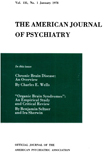GENETIC ASPECTS OF PREADOLESCENT SCHIZOPHRENIA
Abstract
The investigative data available at this time may be summarized as follows:
1. In comparing the family backgrounds of preadolescent schizophrenia case (52 twins and 50 singletons under age 15) with those of a comparable adult sample (691 twin index cases), no significant inter-group differences have been found either with respect to twin concordance rates or with respect to the schizophrenia rates for the parents (12.5% and 9.2%) and sibs (12.2%) and 14.3%) of the index cases. Fathers and mothers contribute equally to the parental schizophrenia rate, while two-egg and one-egg co-twins of schizophrenic index cases differ as much in concordance for preadolescent schizophrenia (17.1% and 70.6%) as they do with regard to adult schizophrenia (14.7% and 85.8%) . These findings indicate an early effect in childhood schizophrenia of the same genotype (gene-specific deficiency state) assumed to be responsible for the basic symptoms of adult schizophrenia. This conclusion is supported by the observation that the psychoses in the co-twins of early schizophrenia cases occur sometimes before and sometimes after adolescence.
2. While the etiological mechanism underlying the relatively infrequent activation of a schizophrenic psychosis before adolescence has not yet been adequately identified, it would seem to be connected with variable constellations of secondary factors lowering constitutional resistance. There appears to be an increase in the number of early schizophrenia cases among the co-twins and sibs of early index cases, and there is a definite excess of males over females in the preadolescent group. Theories attempting to explain either finding on non-biological grounds lack substantiation.
3. Because of a dearth of statistically comparable data, it is difficult to appraise the part played by a poor home with disturbed intrafamily relationships in the etiology of childhood schizophrenia as compared with that of adult schizophrenia. It is certain only that there is no simple correlation between inadequacy of the parental home and a preadolescent onset of schizophrenia, and that a late onset of the disease is not always associated with favorable home conditions in childhood. In the present study, 71.4% of the homes of all sibs and dizygotic co-twins, and 82% of the homes of co-twins and sibs diagnosed as schizoid or schizophrenic, have been broadly classified as inadequate. In evaluating this finding it is necessary to bear in mind, however, that of all the normal co-twins and sibs, nearly two-thirds (64.8%) have come from an inadequate home identified with the development of schizophrenic phenomena in the index case.
4. Since an adequate home cannot be expected either to preclude an early onset of schizophrenia in especially vulnerable childern or to be easily established in the presence of emotionally unstable parents, the need for systematic and intensified research into the genetic aspects of both preadolescent and adult forms of schizophrenia remains a major challenge to our discipline.
Access content
To read the fulltext, please use one of the options below to sign in or purchase access.- Personal login
- Institutional Login
- Sign in via OpenAthens
- Register for access
-
Please login/register if you wish to pair your device and check access availability.
Not a subscriber?
PsychiatryOnline subscription options offer access to the DSM-5 library, books, journals, CME, and patient resources. This all-in-one virtual library provides psychiatrists and mental health professionals with key resources for diagnosis, treatment, research, and professional development.
Need more help? PsychiatryOnline Customer Service may be reached by emailing [email protected] or by calling 800-368-5777 (in the U.S.) or 703-907-7322 (outside the U.S.).



